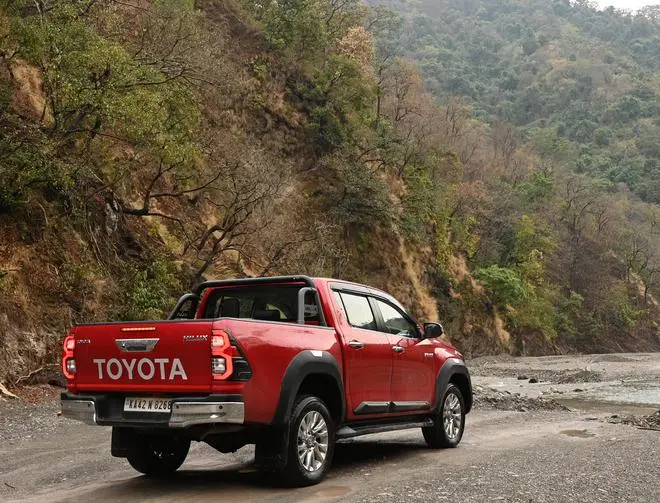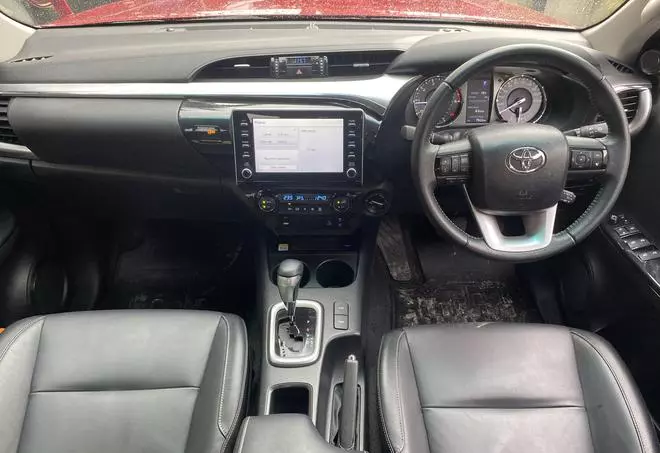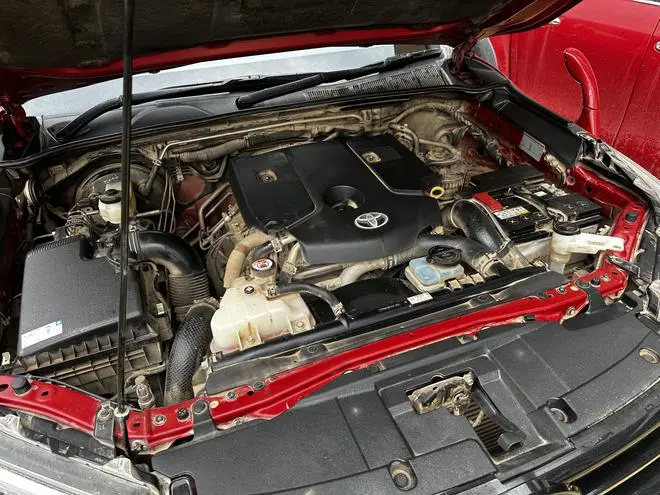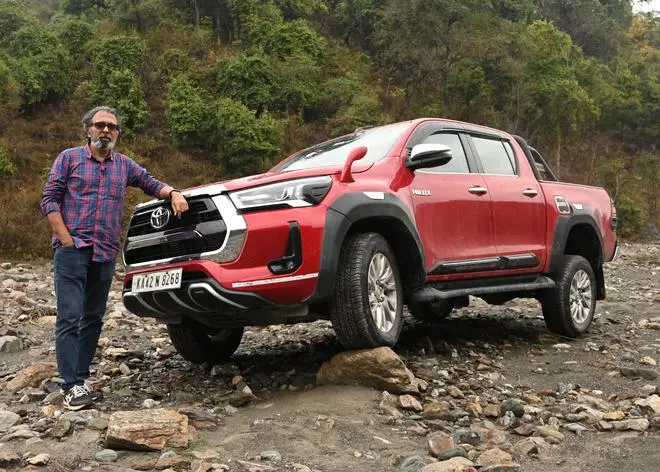The pickup truck market is unlikely to grow to be a sizeable market any time soon. Yet, it is underserved simply due to lack of choice. It is also split into two distinct segments: the commercial utilitarian and the premium lifestyle-focused. The twain do meet, but that mid-segment overlap would be a small number. And the truly premium pickup truck market is yet to witness a bevy of competitors, which would then help expand the market.
The Toyota Hilux is probably one of the first premium pickup trucks to be launched. After a soft launch in Q1 2022, taking in only a limited number of bookings, Toyota had stopped taking new bookings later due to supply constraints. It has now decided to open bookings for a larger number of potential buyers. It will be an inevitable premium positioning for the Hilux, with its prices ranging from about ₹34 lakh to ₹40 lakh. This also means that it is likely to be largely in demand among urban buyers who are looking for a vehicle to make a lifestyle statement. Yes, there will also be a small minority that are fans of the great outdoors and will choose the Hilux for its legendary four-wheel drive and off-roading abilities.
Design and build

A unique set of LED taillamps and the flip-down tailgate allowing access to the load deck are the features at the rear | Photo Credit: BIJOY GHOSH
Toyota has taken its time bringing the Hilux to our shores. This pickup completes the trio of vehicles built on the IMV platform (Innovative Multipurpose Vehicle). Of course, the two that share the platform and are already plying our roads are the Innova and the Fortuner. The IMV platform was specifically developed for building these vehicles and for markets like Thailand, Indonesia, and India. The Hilux has been around longer though, nearly five decades to be precise, and has sold more than 20 million units in over 180 countries. The hallmark of the Hilux is its rigid body on frame chassis and its extreme off-road capabilities in the toughest of terrain, which has been the reason for its bulletproof reliability. The strong, high-set, macho stance comes from a pickup design that delivers the right mix of practicality and modernity. It is offered only with this combination of a four-door dual cab and load deck at the rear, which, despite its rather suave finish, can handle a payload of nearly 500 kg. However, the loading lip is quite high, and though the tailgate is offered with the convenience of soft opening and closing hydraulic struts, you will probably need a ramp to load stuff, including bikes, or a quadricycle etc.
There are mild design references at the front to other IMV platform vehicles, but the Hilux is still quite distinctive. At 5.3-metres long, it is a big vehicle for urban Indian conditions. Adding to that big pickup stance is the thick chrome frame for the bonnet grille, with the Hilux branding on a chrome slat sitting just below the Toyota logo. LED headlamps, DRLs, and fog lamps are some of the other features. There will be minor differences in some of the features based on the trim variant, and, of course, some of the chrome accessories, over-fender, matt-black roll-bar, fender mirror, and stickers that you see in these pics of my test mule will be optional additions. A unique set of LED taillamps and the flip-down tailgate allowing access to the load deck are the features at the rear. The optional accessory that some customers may like is the split, sliding open rear glass behind the dual cab, instead of the long, fixed glass my test mule sported. From the side, the size of the Hilux and its 3-metre wheelbase hits me. Its raised suspension and the 29-degree approach and 26-degree departure angles deliver the visual impact of a capable off-roader. The big gap within the wheel arches would have looked awkward in a SUV, but in the Hilux, it seems apt.
Cabin and features

The dashboard is a vertically stacked layout, typically SUV-like | Photo Credit: BIJOY GHOSH
It is a bit of a climb into the Hilux’s cabin. You will need the help of the floorboard and the grab handle on the A-pillar to heave yourself in. What you see in these pictures is the cabin of the top-trim AT auto-transmission variant; there are likely to be some differences with the base trim manual transmission variant. The dashboard is a vertically stacked layout, typically SUV-like. The high-set aircon vents, the moulded instrument binnacle, and the dash IP create a layout that is focused on practicality, and even though it looks a little dated in terms of design, the elements do come across as being right for a pickup. The plastics used for the dash, door panels and some of the other trim elements come across as hard touch and would belong more in the C-segment. My top trim test mule did make up for some of that price-to-perceived value mismatch with its stitched leather seats and leather-wrapped steering wheel.
The controls on the multi-function steering wheel and the quality of the 8-inch infotainment screen and its controls are also a bit dated, but in terms of functionality, they offer quite a range, including cruise control. There is auto climate control (the base MT gets manual aircon), auto down and up power windows for all four doors, and an electrochromic rear-view mirror. The instrument cluster features a pair of analog pods for speedo and odo. There is also a small digital MID in the centre, which provides key drive related info. There are a lot of storage options, including a cooled glovebox and bottle and cup holders in the centre console and door pockets. The bucket seats are comfortable for the driver and front passenger. The rear seat, though, can feel a bit cramped. Legroom and headroom aren’t generous by D-segment standards, and the backrest is a bit too upright. Top trim variant’s driver seat gets power adjustments.
Engine and transmission

The 2,755 cc engine delivers the same peak power of 204 PS for both the manual transmission and automatic gearbox | Photo Credit: BIJOY GHOSH
The Hilux shares its 2.8-litre diesel engine with the Fortuner, making it the closest platform sibling. The 2,755 cc engine delivers the same peak power of 204 PS for both the manual transmission and automatic gearbox. Peak torque generated is, however, lower at 420 Nm for the manual transmission and higher at 500 Nm for the auto transmission. The good thing though is that much of that torque is available from a low 1,400rpm or so. With the typical diesel powertrain character, the engine also delivers peak power from about 3,000 rpm. Even though the power band is relatively narrow, the engine never felt strained during my test drive. It does get a bit clattery and loud at high revs but didn’t run out of breath. Even on regular roads, it feels quick and even while clocking 3-digit speeds, it feels like there is still room for more performance from the engine. The Hilux AT also gets Eco and Power drive modes to choose from, with changes to throttle response being the only difference in character. Manual gear selection is possible using the gear stick, steering mounted paddles are not on offer.
The manual transmission variants (standard and high) also get what Toyota officials call intelligent manual transmission (iMT), which is essentially the ECU calibration enabling rev-matching to ensure there is less shift shock during gear changes. The clutch exists and needs to be engaged during manual gear selection.
Off-road prowess

If going off the grid and attempting to traverse challenging routes is your thing, the Hilux is the vehicle to buy | Photo Credit: BIJOY GHOSH
The Hilux’s playground is the desert, the mountains, and everything in between. It wasn’t going to be worth the experience if I was to have been offered the opportunity to drive on the highway between two cities, even though most buyers will probably be doing that. So, it was a pleasant surprise when I realised that Toyota (usually overly cautious with its choice of route) had put together a tough, technical off-road section within Rajaji National Park, near Rishikesh. The route took me through a mix of regular tarmac and kutcha roads inside the park and then a rocky, precarious climb down involving multiple hairpins carved out of a hillside. The final stretch was entirely on a riverbed, requiring me to negotiate a route between boulders, negative and positive inclines along the riverbank, and ford multiple streams with the water level in places as deep as 700mm.
The Hilux sports four-wheel drive with a high and low range. A selector knob helps choose between H2 (high 2WD), H4 (high 4WD), and L4 (low 4WD) settings. The electronic differential lock, downhill assist control, and active traction control features came in handy during the off-road session, helping make small adjustments to put the Hilux gingerly through some tight spots while offering a lot of control and sure-footedness. The Hilux’s frame, famous for its excellent torsional and bending rigidity, is perfect for handling the torture of extreme off-roading. It would have been useful on regular tarmac too, except for the leaf-spring rigid axle suspension at the rear, which makes the ride a bit bouncy on uneven blacktop tarmac, though it does complement the chassis during off-road excursions. The same is the case with the heavy steering, which could be cumbersome to use during tight u-turns in cities.
Bottom Line
If going off the grid and attempting to traverse challenging routes is your thing, the Hilux is the vehicle to buy. You can carry and pitch your tent, take that quad bike on the deck, and explore even more of the great outdoors etc. But if you are considering the Hilux for its lifestyle image value and not really for its true prowess, I’m not going to dissuade you. Though you could also pause and consider the other options in the same price range. There are a few SUVs that will offer more value and more features for the same price tag.





Comments
Comments have to be in English, and in full sentences. They cannot be abusive or personal. Please abide by our community guidelines for posting your comments.
We have migrated to a new commenting platform. If you are already a registered user of TheHindu Businessline and logged in, you may continue to engage with our articles. If you do not have an account please register and login to post comments. Users can access their older comments by logging into their accounts on Vuukle.